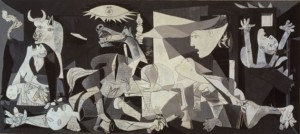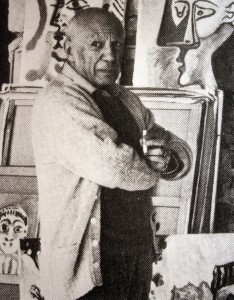Pablo Picasso was born in Málaga, Spain in the year 1881. He went on to become on the greatest and most influential artist of the 20th century and is credited with being the creator of Cubism. He was talented in painting, sculpting, printmaking, making ceramics and was a stage designer. Picasso has a large body of work that can still be seen today throughout the world even though he passed away after 91 years of living on April 8, 1973, in Mougins, France.
Destined for greatness from a young age, Picasso was taught by his father to paint and draw at a young age only to surpass his father in skill by the age of thirteen. One year later, his family made the move to Barcelona where Picasso applied and got accepted to the prestigious School of Fine Arts. The only problem was that this school had very strict rule that made Picasso not so keen about it, resulting in him skipping classes to walk around Barcelona and sketching the city. Even at this young age, he had a thirst for art that was unique and different from previous artist. This thinking led to a lifelong journey of experimentation and innovation in art.
Entering what historians have called the “Blue Period” of Picasso’s life, Pablo has moved to France and opened a studio. This “Blue Period” is one in which most of Picasso’s work is predominantly painted with blue. It is also a reflection into how he was feeling at the time, with the death of his close friend, Carlos Casagemas, weighing on his heart. The scenes of poverty, anguish and isolation reflected his own loneliness and depression. A few painting from that time period include “La Vie” and “Blue Nude”.
The next period, the “Rose Period”, a much happier time in his life after mostly overcoming the depression that had affected him so much. He had fallen madly in love with Fernande Olivier, a beautiful model. He was also given a generous amount of money from the art dealer Ambroise Vollard. This period also introduced the use of warmer colors as opposed to the use of blue that he was once known for using. “Family at Saltimbanques” and “Gertrude Stein” are a couple of famous works of his from this time in his life.

Gertrude Stein
by Matthew Benjamin Coleman, used under CC0
A new era in art started in 1907 due in large by Picasso and a piece of artwork of his, the “Les Demoiselles d’Avignon”. This was unlike anything at the time not because of what it depicted so much as how it was presented, with sharp geometric shape and the use of stark blotches of colors, varying from blues, greens and grays. This painting is widely regarded as what begun Cubism. Cubism started a new style of painting that had never before been used and was not looked upon fondly at first. The abstract shapes and colors used were so unusual at the time that people did not know what to make of it and thus were critical of it. This did not stop Picasso though who continued with using cubism and included it in other works of his later on his life.
!["Les Demoiselles d'Avignon [1907]" by NichoDesign](http://blogs.butler.edu/sp14group6/files/2014/04/10962238535_d8b09257e0_b-285x300.jpg)
Les Demoiselles d’Avignon [1907]
by NichoDesign, used under CC0
After a time of doing Cubism, Picasso ventured back towards reality with the beginning of World War I. This is referred to as the “Classical Period” in Picasso’s life due to his return to realism. Some notable work from this period include “Three Woman at the Spring” and “The Pipes of Pan”.
Finishing off the eccentric career of Picasso was a period of time till he died that was dominated by a style of art called surrealism. This art form manifested itself from his own cubism work. This new work of Picasso’s is epitomized by one of his works that is often deemed his greatest work of all time, “Guernica”. This painting showed the horrors of war in a way only Picasso could visualize and make reality.

Picasso Guernica
by ROBERT HUFFSTUTTER, used under CC0
This illustrious career of Picasso was dynamic, with him jumping from different art styles his entire career. To find out more about Pablo Picasso, click this link where you can a gain a greater understanding of the life and art of the great Spanish painter Pablo Picasso.
Pablo Diego José Francisco de Paula Juan Nepomuceno María de los Remedios Cipriano de la Santísima Trinidad Martyr Patricio Clito Ruíz y Picasso. (2014). The Biography.com website. Retrieved 12:51, Apr 14, 2014, from http://www.biography.com/people/pablo-picasso-9440021.
Pablo Picasso. (n.d.). – paintings,biography,quotes of. Retrieved , from http://www.pablopicasso.org/
Voorhies, James. “Pablo Picasso (1881–1973)”. In Heilbrunn Timeline of Art History. New York: The Metropolitan Museum of Art, 2000–. http://www.metmuseum.org/toah/hd/pica/hd_pica.htm (October 2004)
Coleman, M. (Photographer). (2009, October 30). Gertrude Stein [Web Photo]. Retrieved from https://www.flickr.com
Maria-ll. (Photographer). (2008, March 30). Pablo Picasso [Web Photo]. Retrieved from https://www.flickr.com
Nichodesign. (Photographer). (2011, November 21). Les Demoiselles d’Avignon [1907] [Web Photo]. Retrieved from https://www.flickr.com
Robert Huffstutter. (Photographer). (2010, December 13). Picasso Guernica [Web Photo]. Retrieved from https://www.flickr.com

